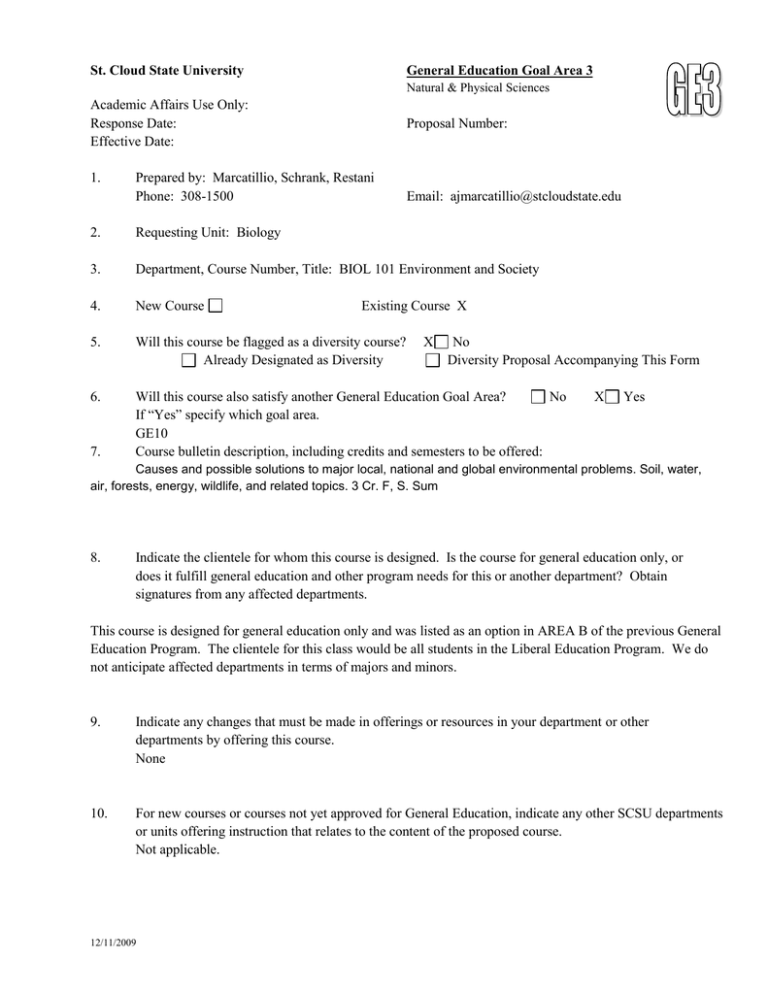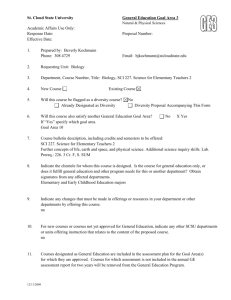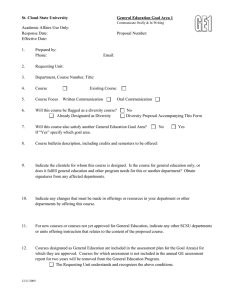Academic Affairs Use Only: Response Date: Proposal Number:
advertisement

St. Cloud State University General Education Goal Area 3 Natural & Physical Sciences Academic Affairs Use Only: Response Date: Effective Date: 1. Proposal Number: Prepared by: Marcatillio, Schrank, Restani Phone: 308-1500 Email: ajmarcatillio@stcloudstate.edu 2. Requesting Unit: Biology 3. Department, Course Number, Title: BIOL 101 Environment and Society 4. New Course 5. Will this course be flagged as a diversity course? Already Designated as Diversity 6. Will this course also satisfy another General Education Goal Area? No If “Yes” specify which goal area. GE10 Course bulletin description, including credits and semesters to be offered: 7. Existing Course X X No Diversity Proposal Accompanying This Form X Yes Causes and possible solutions to major local, national and global environmental problems. Soil, water, air, forests, energy, wildlife, and related topics. 3 Cr. F, S. Sum 8. Indicate the clientele for whom this course is designed. Is the course for general education only, or does it fulfill general education and other program needs for this or another department? Obtain signatures from any affected departments. This course is designed for general education only and was listed as an option in AREA B of the previous General Education Program. The clientele for this class would be all students in the Liberal Education Program. We do not anticipate affected departments in terms of majors and minors. 9. Indicate any changes that must be made in offerings or resources in your department or other departments by offering this course. None 10. For new courses or courses not yet approved for General Education, indicate any other SCSU departments or units offering instruction that relates to the content of the proposed course. Not applicable. 12/11/2009 11. Courses designated as General Education are included in the assessment plan for the Goal Area(s) for which they are approved. Courses for which assessment is not included in the annual GE assessment report for two years will be removed from the General Education Program. X The Requesting Unit understands and recognizes the above conditions. 13. Provide a concise explanation of how the following goal is a “significant focus” of the proposed course. Goal Area 3: Natural & Physical Sciences Explore scientific knowledge of the natural world. Understand the central concepts and principles of science; experience the process of scientific inquiry; comprehend science as a human endeavor and understand the impact of science on individuals and on society. This course utilizes the scientific method (basic and applied) to examine environmental processes and identifies environmental problems and potential solutions. Laboratory exercises, reading primary and secondary literature, video presentation, take home assignments and lectures are integrated to demonstrate the scientific approach to environmental issues. 14. In order for a course to be designated as fulfilling Goal Area 3, it must address at least 5 of the 6 student learning outcomes (SLOs) below. Check the SLOs below that are focused on in the proposed general education course. X 1. Demonstrate knowledge of concepts, principles, and theories in the physical or natural sciences. X 2. Make observations and collect data, design and carry out experiments or other types of scientific investigations. X 3. Formulate research questions and testable hypotheses, analyze and interpret data, draw inferences and conclusions, and identify further questions for investigation. X 4. Demonstrate awareness of the interdependent relationships of basic science, applied science, mathematics, and technology. X 5. Recognize the human nature of the scientific enterprise, including the importance of curiosity, creativity, and imagination; the dual nature of scientific knowledge as changeable and durable; and the impact of a scientist's personal identity on the scientific process. X 6. Evaluate societal issues from a science perspective, question the evidence presented, and make informed judgments about these issues. 15. Discuss how each Student Learning Outcome checked above is achieved in this course. (Note: Although descriptions of typical assignments or types of assignments may be part of this discussion, it is not appropriate to submit copies of actual assignments.) Fulfilling Goal Area 3 1. Demonstrate knowledge of concepts, principles, and theories in the physical or natural sciences. Students learn principles of the interrelatedness of matter, energy, and the environment. In completing problem sets, unit exercises, laboratory reports or evaluation of assigned papers, they demonstrate their understanding of these principles and their ability to apply them to real world examples. 12/11/2009 2. Make observations and collect data, design and carry out experiments or other types of scientific investigations. Students learn about the scientific method through assigned readings and handouts. They demonstrate their ability to apply knowledge through critique of case histories, suggestions for improvement of experimental design for applied environmental problems (e.g. testing effectiveness of modifying traffic flow in large cities), and testing hypotheses using computer simulations of demographic data. 3. Formulate research questions and testable hypotheses, analyze and interpret data, draw inferences and conclusions, and identify further questions for investigation. Students formulate research questions and test hypotheses using population statistics and programs for demography. They can formulate research questions and modify variables such as energy input, population size, and fertility rates. They then use computer models to determine the validity of their predictions. 4. Demonstrate awareness of the interdependent relationships of basic science, applied science, mathematics, and technology. During the introductory unit for the course, students evaluate sources of information (data from fields such as engineering, law, ethics, biology, psychology, social science, physics, economics, chemistry, and earth sciences) that are applied in the solution of complex environmental problems. They are asked to indicate what each source of information contributes to the potential solution and why input from diverse sources is valuable. 5. Recognize the human nature of the scientific enterprise, including the importance of curiosity, creativity, and imagination; the dual nature of scientific knowledge as changeable and durable; and the impact of a scientist’s personal identity on the scientific process. Students complete three units of readings on anthropogenic activity and the environment and one unit on scientific knowledge and its use in environmental policy and decision making. Students evaluate and critique examples from case histories and the current literature related to changes in environmental policy based on scientific studies. Selected case histories and showcase not only the science but also the background and passion of the scientist (e.g. Garrett Hardin and Wangari Maathai). 6. Evaluate societal issues from a science perspective, question the evidence presented, and make informed judgments about these issues. Students complete a unit containing case studies and environmental global perspectives of environmental interrelationships and critique management and sustainability strategies in diverse ecosystems (e.g. greater Yellowstone ecosystem, Mekong River delta, etc.). Students are asked to suggest alternative management strategies or justify existing ones based on their understanding of the evidence presented. 16. Courses satisfying Goal Area 3: Natural & Physical Sciences must have either a “traditional lab course or a lab-like experience”. Check which of these apply and supply a brief explanation of how the course is either a laboratory course or incorporates a “lab-like experience”. Course includes: X Laboratory Lab-like experience 12/11/2009 The following quote from a National Research Council subcommittee report may help to identify a course with a laboratory. ”Laboratory experiences provide opportunities for students to interact directly with the material world (or with data drawn from the material world), using the tools, data collection techniques, models, and theories of science.” America's Lab Report: Investigations in High School Science (Free Executive Summary) http://www.nap.edu/catalog/11311.html Students will conduct a number of exercises in data collection/analysis/interpretation/presentation on environmental processes from actual and simulated online exercises. 17. List or attach the Course Outline (adequately described and including percentage of time to be allocated to each topic). Curriculum Committees may request additional information. Topics larger than 20% need to be broken down further. Indicate in your course outline where the Student Learning Outcomes checked above are being met. Course Outline Foundation of Environmental Science 15% Principles of Science and Ecology 17% Population Ecology 17% Applying Science to Pollution Problems 17% Human Impact on Land and Biosystems 17% Energy 17% 12/11/2009 Alignment with SLO’s 1-2-5 1-2-5 1-2-4-6 2-3-4-5-6 2-3-4-6 1-2-4-6 St. Cloud State University General Education Transmittal Form Academic Affairs Use Only: Response Date: Effective Date: Proposal Number Department: Course or Course(s): Department or Unit Chair Signature Date Department forward to Academic Affairs for publication and electronically to Chair of General Education Committee, Chair of College Curriculum Committee, College Dean Recommendation of General Education Committee: Approve Remarks: Disapprove Chairperson Committee Signature Date Recommendation of University Curriculum Committee: Approve Remarks: Disapprove Chairperson Committee Signature Date Recommendation of Faculty Association: Approve Remarks: Disapprove FA Senate Signature Date Action of Academic Vice President: Approve Disapprove Signature Entered in Curriculum Data File 12/11/2009 Remarks: Date

